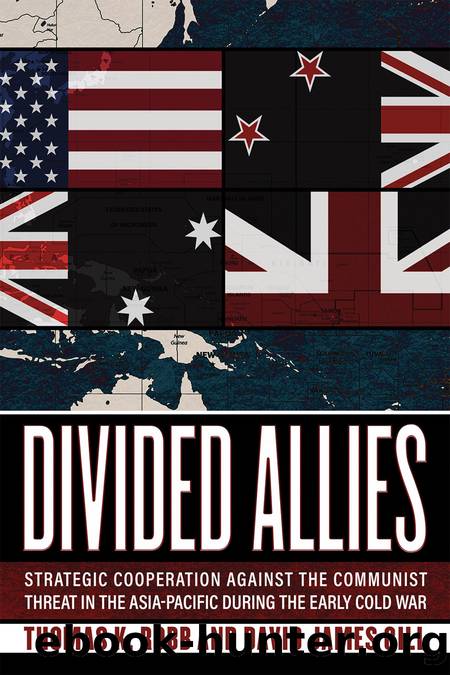Divided Allies by Thomas K. Robb;David James Gill; & David James Gill

Author:Thomas K. Robb;David James Gill; & David James Gill
Language: eng
Format: epub
Publisher: Lightning Source Inc. (Tier 3)
Published: 2019-08-17T00:00:00+00:00
Collective Security
U.S. efforts to win international support began in earnest with Dulles delivering his “united action speech,” officially titled “The Threat of a Red Asia,” on March 29, 1954. He warned that “if Communist forces won uncontested control over Indochina or any substantial part thereof, they would surely resume the same pattern of aggression against other free peoples in the area…. The United States feels that that possibility should not be passively accepted but should be met by united action.”49 As Dulles had agreed with the president prior to delivering his speech, the language he used would clearly illustrate that the United States was not “appeasing” the People’s Republic of China. Instead, it would serve as a strong statement that emphasized to the press the commitment of the United States to “deeds” and not just “words.”50 Eisenhower supported Dulles’s efforts by emphasizing publicly the strategic importance of retaining Indochina in the Western camp. As the president told reporters, the loss of Indochina to Communism was “incalculable to the free world.”51
Washington’s attention turned toward London.52 On liaising with British officials, Dulles found that there was limited enthusiasm for united action in Indochina. They believed that intervention was likely to precipitate a war against the PRC in a similar fashion to events during the Korean War. Having brokered a cease-fire only a year earlier with North Korea, there was little enthusiasm in London for another major crisis.53 More alarming yet, the British believed that if any such war escalated, it would likely lead to Soviet intervention, which would escalate into a global conflagration and produce what Churchill feared the most: “an assault by hydrogen bombs” on the United Kingdom.54 As the prime minister remarked a year earlier, he had “lived seventy-eight years without hearing of bloody places like Cambodia” and he therefore saw no reason to allow East-West disputes over such places to lead to global war.55 In a secret planning paper, however, British intelligence had called Indochina the “front line of the Cold War in South-East Asia.”56 Yet this conclusion did not necessitate a military response for the British cabinet. The British believed that such action was futile, as a war against the PRC would escalate quickly to involve the Soviet Union. London’s reaction to a New Zealand staff paper, which suggested that planning for a war solely against the PRC should begin, highlighted a clear reluctance to commit to military force.57
Although the British government was reluctant to support united action as currently proposed, it did welcome the opportunity to capitalize on U.S. proposals and pursue its interests in the region. As London informed Washington, it was open to creating an alliance of Asia-Pacific powers of a “more general and enduring nature,” which contradicted Dulles’s preference for a “temporary arrangement.”58 The British government saw these U.S. proposals for united action as a means of securing their long-term ambition of creating a broader alliance in the Asia-Pacific that included both British and U.S. participation and rectified their continuing exclusion from ANZUS and strategic planning in the region more generally.
Download
This site does not store any files on its server. We only index and link to content provided by other sites. Please contact the content providers to delete copyright contents if any and email us, we'll remove relevant links or contents immediately.
| Arms Control | Diplomacy |
| Security | Trades & Tariffs |
| Treaties | African |
| Asian | Australian & Oceanian |
| Canadian | Caribbean & Latin American |
| European | Middle Eastern |
| Russian & Former Soviet Union |
The Secret History by Donna Tartt(16611)
The Social Justice Warrior Handbook by Lisa De Pasquale(11486)
Thirteen Reasons Why by Jay Asher(7783)
This Is How You Lose Her by Junot Diaz(5754)
Weapons of Math Destruction by Cathy O'Neil(5032)
Zero to One by Peter Thiel(4818)
The Myth of the Strong Leader by Archie Brown(4786)
Promise Me, Dad by Joe Biden(4441)
Stone's Rules by Roger Stone(4413)
Beartown by Fredrik Backman(4405)
How Democracies Die by Steven Levitsky & Daniel Ziblatt(4393)
The Fire Next Time by James Baldwin(4338)
100 Deadly Skills by Clint Emerson(4072)
A Higher Loyalty: Truth, Lies, and Leadership by James Comey(4027)
Rise and Kill First by Ronen Bergman(4009)
The David Icke Guide to the Global Conspiracy (and how to end it) by David Icke(3876)
The Farm by Tom Rob Smith(3870)
Secrecy World by Jake Bernstein(3774)
The Doomsday Machine by Daniel Ellsberg(3726)
